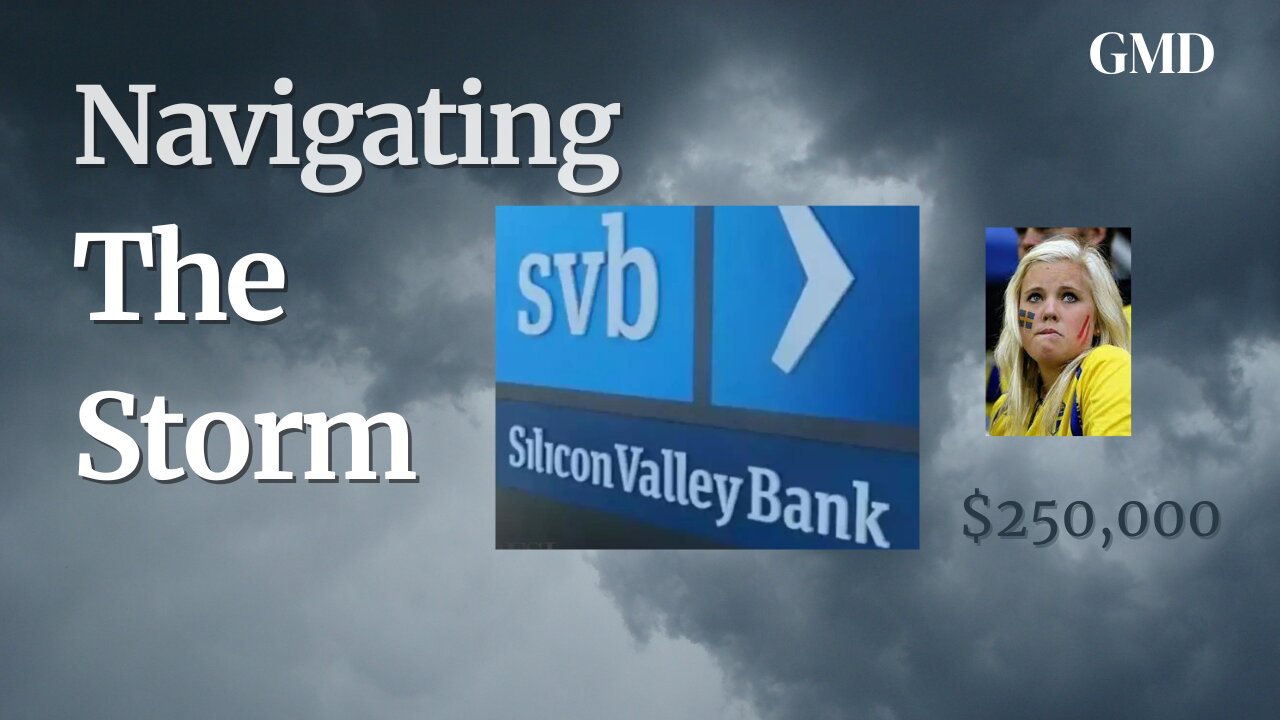Premium Only Content

Navigating The Storm
There is good reason to believe that the U. S. economy is on the verge of a major and prolonged decline. If that assessment is correct, a decline in the economy will certainly be accompanied by a major decline in the stock market. Investors need to take steps immediately to protect themselves and their savings from such an eventuality.
There are several reasons to believe this. The first reason is that Federal Reserve interest rate policy and monetary policy have been devastating to the economy.
The Fed began raising interest rates in March of 2022. Every month since December of 2022 the U.S. money supply, as measured by both M-1 and M-2, has been contracting.
The Fed began raising interest rates in March of 2022. Every month since December of 2022 the U.S. money supply, as measured by both M-1 and M-2, has been contracting.
And this decline in the money supply has gotten progressively worse each month since December of 2022. Over that period, the M-1 measure has contracted by 2.5%. The M-2 measure has contracted by 9.25%.
The data for these calculations can be found on the web page of the Board of Governors of the Federal Reserve System. The page is entitled Money Stock Measures – H.6 Release. Table 1.
The negative effects of the increases in interest rates are only now beginning to weave their way through the economy. This is reflected in recent reports about troubles in the banking sector and in the real estate sector.
In 2023 we saw three of the largest bank failures ever witnessed in the United States. First Republic Bank, Silicon Valley Bank, and Signature Bank were all taken over by Federal bank regulators. However, the measures that were taken by the regulators at that time camouflaged the underlying causes of the collapse; they did not remedy the underlying problems.
The underlying cause was that the sudden increase in interest rates caused a massive decline in the value of billions of dollars of Treasury bonds and other assets that were held by those banks.
Many other banks have similar serious flaws as those three. There is fear that those problems will reassert themselves and that, as a result, a collapse in the banking system and a collapse in the commercial real estate market will follow later this year.
The underlying flaws in the banking system were never really fixed. The crisis is beginning to reemerge as $5 trillion of commercial real estate debt taken out during the zero-rate era comes due.
Professor Tomasz Piskorski, is a banking specialist at Columbia University. He offered the following analysis: “It’s not a liquidity problem; it’s a solvency problem. Temporary measures have calmed the market but half of all U. S. banks are running short of deposits with assets worth less than their liabilities. The total amount of the shortfall is $9 trillion.”
He believes that the values of commercial office buildings have fallen by 50 percent on average from their peak, and 45 percent of all office loans are currently under water; that is, in negative equity.
Professor Piskorski is but one of many observers who foresee impending doom in the commercial real estate market, and believe that this will be accompanied by widespread loan defaults and bank failures. Hundreds of banks will disappear.
In fact, The Social Science Research Network recently reported that 186 banks in the United States are at risk of failure or collapse due to rising interest rates and a high level of uninsured deposits that they are holding.
There is not a consensus among Wall Street strategists over where the stock market will go from here. However, the head of technical strategy at JPMorgan believes that the S&P 500 will plummet by the middle of 2024. He sees the S&P 500 falling to around 3,500, and he believes that investors should reduce their exposure to stocks. He recommends U. S. Treasuries having a short duration.
So, how should an investor prepare? What can an investor do to protect his or her assets?
The safest are money market accounts, certificates of deposit, cash management accounts, and high yield savings accounts that are insured by the Federal Deposit Insurance Corporation.
All of these accounts are guaranteed by the Federal Deposit Insurance Corporation. The F. D. I. C. guarantees all of these deposits up to a maximum of $250,000 per investor and per institution.
This vlog covers all of the following subjects:
Preparing for a market crash
Preparing for a stock market crash
Federal Reserve interest rate policy and monetary policy
Mistakes that the Federal Reserve has made
Countless blunders of the Federal Reserve
The Federal Reserve has not served the country well.
Investors need to protect themselves and their savings.
a decline in the economy will certainly be accompanied by a major decline in the stock market
Largest ever bank collapses
S&P 500
S&P 500 will plummet
Collapse of the banking system
U. S. Treasuries having a short duration.
-
 1:31:04
1:31:04
Rebel News
2 days agoTommy Robinson & Avi Yemini Banned from Al-Aqsa mosque!
16.3K38 -
 16:07
16:07
Nikko Ortiz
2 days agoSora 2 Must Be Stopped
3.92K5 -
 LIVE
LIVE
Lofi Girl
3 years agolofi hip hop radio 📚 - beats to relax/study to
122 watching -
 59:58
59:58
Man in America
11 hours agoHow Big Pharma Turned Cancer Into a TRILLION-DOLLAR Business
351K39 -
 9:11:52
9:11:52
SpartakusLIVE
9 hours ago#1 Solo Savant stream DEEP into the night || PUBG Later Tonight?!
73.4K5 -
 13:56
13:56
Clintonjaws
14 hours ago $33.57 earnedEntire Room Speechless As Poilievre Snaps & Puts TV Hosts In Their Place
49.5K25 -
 4:23:32
4:23:32
EricJohnPizzaArtist
1 day agoAwesome Sauce PIZZA ART LIVE Ep. #67: HALLOWEEN SPECIAL tribute to “Need to Breathe”
59.7K14 -
 2:26:26
2:26:26
Nerdrotic
10 hours ago $52.95 earned3I/Atlas : A Cosmic Horror or a New Interstellar Understanding? | Forbidden Frontier #122
209K19 -
 54:56
54:56
Sarah Westall
8 hours agoHidden Biblical Writings: Evidence Based Investigation, Worlds First Collection w/ Matthew McWhorter
33.4K26 -
 3:08:48
3:08:48
megimu32
7 hours agoOTS: Great Scott! How Back to the Future Changed Movies Forever
36.7K9